Did You Know?
The test includes 8 sections, each with several difficulty levels that integrate previously assessed abilities. For example, in level 6, you will need the skills from levels 4 and 5.
Our free WorkKeys practice test will guide you through every section, help you locate your weak areas, and provide detailed solutions for all questions.
WorkKeys Practice Test
We will start the WorkKeys practice exam with the first three sections of the assessment, which make the mandatory requirements for receiving the ACT WorkKeys NCRC (National Career Readiness Certificate):
Applied Mathematics – the ability to apply mathematical reasoning, critical thinking, and problem-solving techniques to work-related problems.
Graphic Literacy – the ability to interpret, apply, or compare information presented graphically (charts, graphs, etc.).
Workplace Documents – the ability to read and use written text such as memos, letters, and instructions.
Earning the NCRC will require passing these sections at a score level of 3 and higher.
Read our WorkKeys Test Scores Guide to better understand the requirements.
Afterwards, we will continue with the additional sections of the test –
As in the real test, each section of the WorkKeys practice exam has various difficulty levels, which are explained below.
The first section we will cover is Applied Mathematics.
How can I improve my performance in the WorkKeys Test?
WorkKeys Practice Exam — Applied Mathematics Sample Questions
The WorkKeys Applied Mathematics section has five difficulty levels, ranging from 3 to 7.
You will have 55 minutes to answer 34 questions.
Just like in the actual test, you are welcome and advised to use a calculator, pencil, and pen while solving the WorkKeys practice exam.
WorkKeys Applied Mathematics Test – Level 3 Question
A college fraternity planned a three-day study marathon. On the first day, they studied 75% of the time, ate for 3 hours, and slept the rest of the time. On the second day, they studied 50% of the time, ate for 4 hours, and slept the rest of the time. On the third day, they slept 1⁄3 of the time. How many hours in total did the fraternity members sleep during the three days?
Note that one day contains 24 hours.
A. 15 hours
B. 19 hours
C. 24 hours
D. 38 hours
Answer: the correct answer is B.
Calculate the number of hours the fraternity slept every day:
Start by converting the percentages into absolute hours.
First day (24 hours):
Thus:
The students slept for 3 hours on the first day.
Second day (24 hours):
, hence,
Thus:
Third day (24 hours):

Total number of hours spent in sleep: 3+8+8 = 19
The correct answer is B
WorkKeys Applied Mathematics Test – Level 4 Question
Dan took a two-hour walk around a round lake. The radius of the lake is 6 feet. What was Dan's average speed?
A. 2π feet\hour
B. 16π feet\hour
C. 12π feet\hour
D. 24π feet\hour
Answer: the correct answer is B.
Any time we need to calculate the speed, we should use the formula time x speed = distance:
The time is given. Now, in order to calculate the speed, first find the distance.
The lake is round with a radius of 6 feet. Accordingly, if Dan took a walk around the lake, the distance he walked is also the perimeter of the lake.
Therefore, use the formula of a circle’s perimeter in order to calculate the perimeter of the lake:

Therefore, Dan's average speed is 6π.
If you chose any other answer, review the solution and your calculations.
The correct answer is B
Since time is short, and the questions increase in difficulty through the test, we recommend you practice the test using different tools and see which ones help you answer faster. Calculators, formulas, and scratch pads are valuable, and it is highly recommended that you put them to use – even the simplest calculations should be quickly performed with a calculator to avoid mistakes and to work as methodically as possible.
Why should I practice for the ACT WorkKeys Exam?
WorkKeys Applied Mathematics Test – Level 5 Question
A pencil is sketched using a rectangle and an isosceles triangle. The length of the pencil is 12 inches. The length of the rectangular section is five times longer than its width, and the height of the triangle is 2 inches. What is the perimeter of the pencil?
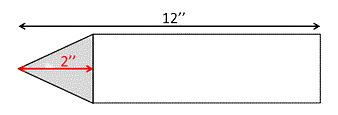
A. ![]()
B. ![]()
C. ![]()
D. Insufficient information
Answer: the correct answer is B.
The full measurements of the pencil are:

Use the image to see if you understand the correct answer.
In order to solve this problem, calculate the length of all outer sides of both the rectangle and the triangle.
From the given information, it is known that the total length of the pencil is 12 inches, and the height of the triangle is 2 inches; therefore, the length of one side of the rectangle is: 12-2 = 10 inches.
Given that one side of the rectangle is five times longer than the other:
And, since opposite sides of a rectangle have the same length (or “congruent”):

In an isosceles triangle, the height is perpendicular to the base and divides the base into two equal parts, thus the sides of the triangle can be calculated using the Pythagorean Theorem:

Therefore:
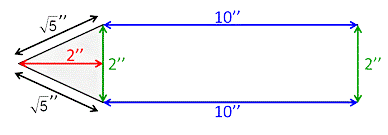
The perimeter of the pencil is:
inches.
If you chose answer (A), you probably confused the base and the other sides of the triangle. If you chose answer (C), you probably forgot to divide the base by two, and if you chose answer (D), review the solution.
The correct answer is B
WorkKeys Applied Mathematics Test – Level 6 Question
Dan is diving in El-Nido in the Philippines. He starts his dive from a boat five meters above sea level (0 meters), and he is descending two meters each minute.
Which of the following describes Dan’s dive as a function of elevation and time?
A.
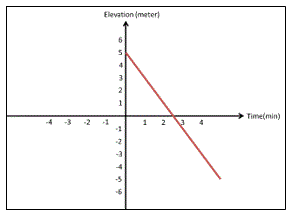
B.
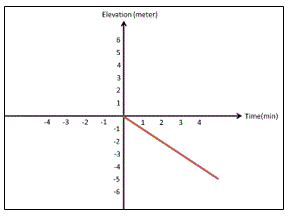
C.
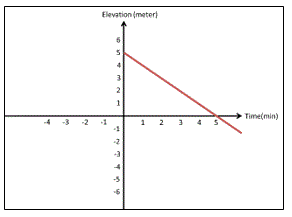
D.
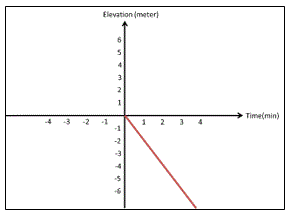
Answer: the correct answer is A.
The line equation: y = mx + n;
m = slope,
n = the intersection point between the line and the y-axis.
The graph is the elevation of Dan relative to the ground as a function of time. The x-axis represents time. The y-axis represents elevation; Dan was five meters above when he dove: i.e he had an elevation of 5 meters, at time = 0 minutes. Therefore, the beginning point is (0, 5).
Dan is diving down at a rate of two meters per minute. This means that the slope is: m = -2 meters/minute
Find the linear equation describing Dan’s dive, using the information you found:


If you chose answer (B), note that the graph starts at the origin. If you chose answer (C), note that the graph’s slope is -1. If you chose answer (D), note that the graph’s slope is -1, and it starts at the origin.
The correct answer is A
Whenever possible, try to simplify the question as much as you can. Not all questions require long equations and solving for variables. Many questions can be answered by using the answers to substitute the unknown factors in the answers, thus eliminating distractors. Consider the previous question (level 6) – and see if you can solve it by common logic (where the graph begins, and how steep should the incline be).
Let’s review the final level of Applied Mathematics.
WorkKeys Applied Mathematics Test – Level 7 Question
Nancy is planning a ring-shaped pool for a new hotel in Florida. The outer diameter of the pool is 100 feet. If the pool has an area of square 1600π ft., which of the following is its inner diameter (the diameter of the dry area)?

A. 60 feet
B. 70 feet
C. 80 feet
D. 90 feet
Answer: the correct answer is A. The outer diameter is 100 feet. Therefore, the radius of the entire shape is 50:
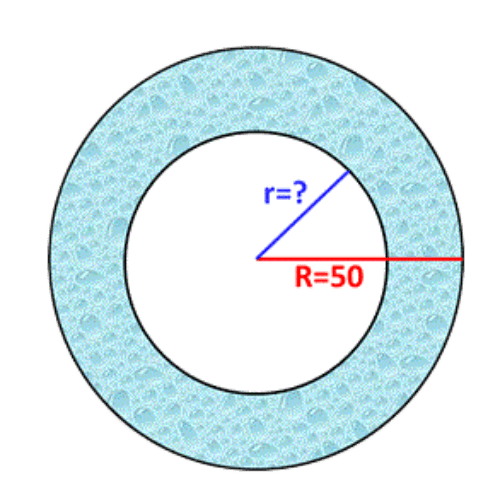
The total area of the pool is the area of the whole shape minus the dry area (da):
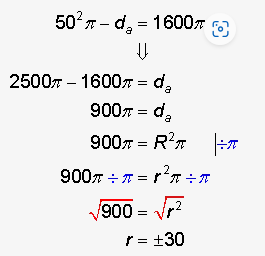
The length of a radius can be only positive; therefore, r = 30.
The diameter (d) equals two times the radius:
d = 2r = 2x30 = 60.
The inner diameter is 60 ft. If you chose any other answer, review your solution.
The correct answer is A
Why is practice important for the WorkKeys Exam's Applied Math?
Once we have completed the Applied Mathematics section, we will move on to the next section – Graphic Literacy. This section also requires mathematical abilities, but this time mainly concerns graphs and tables, which increase in difficulty with the amount of data and requirements in each question.
WorkKeys Practice Exam — Graphic Literacy Sample Questions
The WorkKeys Graphic Literacy section has five difficulty levels, ranging from 3 to 7.
You will have 55 minutes to answer 38 questions.
WorkKeys Graphic Literacy Test – Level 3 Question
The following chart shows the average temperature, in °F, for Monday (orange), Tuesday (yellow), and Wednesday (blue). What was the approximate temperature on Wednesday?
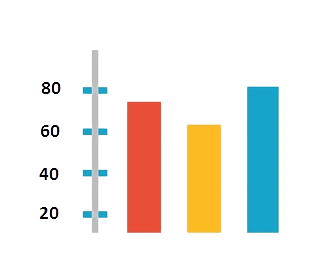
A. 20°F
B. 80°F
C. 70°F
D. 60°F
E. 50°F
Answer: the correct answer is B.
According to the chart, the temperature on Wednesday (represented by the blue bar) reached approximately 80°F.
The correct answer is B
WorkKeys Graphic Literacy Test – Level 4 Question
The following diagram shows the 800 m men's race results at the 1976 Summer Olympics. What was the running time for the runner from India?

A. 1:43.86
B. 1:44.12
C. 1:54.44
D. 1:45.77
E. 1:48.39
Answer: the correct answer is D.
According to the diagram, Sri Ram Singh was the runner from India. His running time is marked as 1:45.77.
While we are sometimes keen to dive deep into the graph and read the introduction, understanding what is that's in front of us may be time-consuming. A simpler method would be to read the question and go directly to the answers, which will help you look strictly for what you need. In the first question – looking at the answers will quickly guide you to each graph.
This is a very useful method for low and high-level questions and should be incorporated into your practice to decide by how much it increases your score. However, ensure you read any notes or essential pieces of information if presented.
Let’s continue with an increasing level of Graphic Literacy questions!
WorkKeys Graphic Literacy Test - Level 5 Question
Below is a pie chart depicting the viewing habits of different age groups in relation to different genres in a specific movie theatre. Each segment of the pie represents about 4% of all movies viewed in an average year. Each segment represents a genre according to the segments key. Each chart is divided into four parts so that each part describes a different age range. These age ranges are represented by different rectangles at the side of the chart.
For example: 75% of the movies viewed by 4–12 year olds are animated films.
Which age group watches fewer movies than any other?
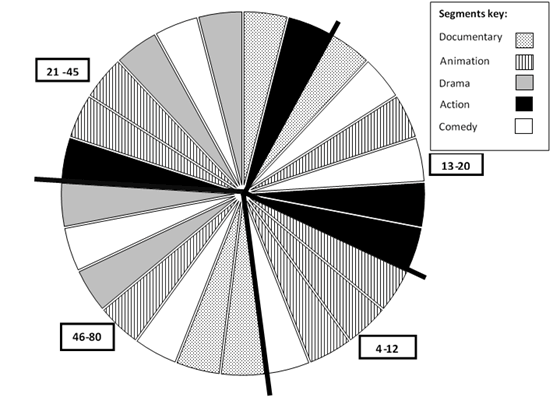
A. 4-12
B. 13-20
C. 21-45
D. 46-80
E. They all have the same proportional viewership
Answer: the correct answer is A.
Because each segment of the chart represents a certain percentage of the films viewed, and because all segments are equal, the age group with fewer segments watches fewer movies.
Counting the number of segments in each age group shows that there are four segments in the age group 4-12. The rest of the age groups have more segments. This age group watches 16% of the films in the cinema, less than any other age group.
This question perfectly illustrates how useful the previous tip was. The information regarding the segment’s key and different movie types is irrelevant; only how many segments each age group holds matters. Starting from the question, you can save valuable time.
The correct answer is A
WorkKeys Graphic Literacy Test – Level 6 Question
You are a police officer in Ciny Town. You have just turned right from Maple St. on your way to the Police Stop Station on Laurence Rd. when you are called to attend an emergency meeting near the other police stop. Which way would you take to arrive at your destination as quickly as possible?
An arrow on a street indicates that, unless otherwise specified, along the entire street traffic is only allowed to travel in the direction in which the arrow is pointing.
Note: Police officers do not have to adhere to traffic regulations during emergencies.
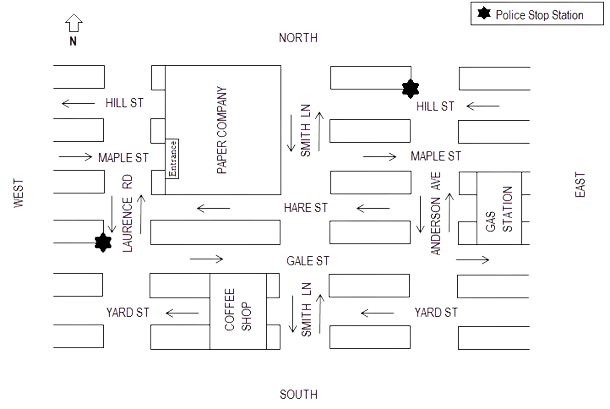
A. Left on Hare St. and left on Anderson Ave.
B. Straight on Laurence Rd., left on Gale St., and left on Anderson Ave.
C. Left on Hare St., right on Smith Ln., and right on Hill St.
D. Left on Hare St. and left on Smith Ln.
E. Left on Hare St. and right on Laurence Rd.
Answer: the correct answer is A.
It is an emergency meeting, so you do not need to regard the traffic regulations.
Answer (B) is incorrect because it would take longer to arrive.
Answer (C) is incorrect because making a right turn on Smith Ln. is going in the wrong direction.
Answers (D) and (E) are incorrect because these routes do not take you to the Police Stop Station.
The correct answer is A
The graphs in the WorkKeys test often contain multiple pieces of data you'll need to cross-reference to answer a question correctly. For example, in the level 5 sample question, you may be asked for the percentage of the overall cinemagoers between the ages 21-45 who went to documentary films (8%). To best cross-reference information, you should:
- Identify Relevant Data Points
- Compare and Contrast
- Re-check the Question
- Eliminate Wrong Choices
Let’s see the final level of the Graphic Literature section!
WorkKeys Graphic Literacy Test – Level 7 Question
Which month reflects an increase in the monthly gross income from the prior month, with the largest drop in the monthly net income?
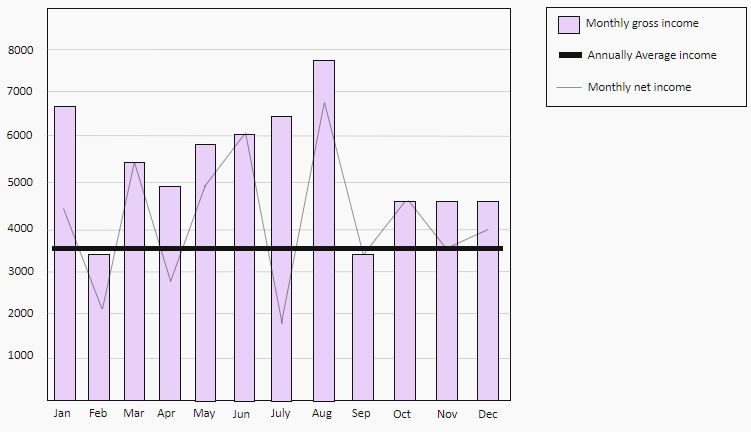
A. February
B. April
C. July
D. September
E. November
Answer: the correct answer is C.
Note that the monthly gross income increases from June to July, while at the same time, the monthly net income decreases from 6000$ to 1800$. This is the largest drop in the monthly income in the presented plot. Therefore, we can see that July has the largest drop in the monthly net income among the months, with an increased gross income from the prior month.
The correct answer is C
How could I better perform in Graphic Literacy questions?
We have one more WorkKeys practice test coming ahead – the Workplace Documents. This section is similar to the previous section as you are required to gather information from presented data; however, this time, the data is shown as a text-written document.
WorkKeys Practice Exam — Workplace Documents Sample Questions
The WorkKeys Workplace Documents section has five difficulty levels, ranging from 3 to 7.
You will have 55 minutes to answer 35 questions.
WorkKeys Workplace Documents Test – Level 3 Question
Safety Guidelines for Warehouse Workers
All warehouse workers must always wear safety gear. This includes:
• Hard hats
• Safety goggles
• High-visibility vests
Equipment such as forklifts should only be operated by certified personnel. Ensure that walkways are clear of objects to avoid trip hazards.
Based on the document, which of the following statements is correct?
A. All workers are required to operate forklifts.
B. Safety goggles are optional for warehouse workers.
C. High-visibility vests are only required for certified personnel.
D. Walkways should be clear to prevent tripping.
E. Hard hats are only required for certified personnel.
Answer: the correct answer is D.
Let’s review each answer:
Answer (A) is incorrect since it is clearly stated that: “Equipment such as forklifts should only be operated by certified personnel.”
Answer (B) is incorrect since it is included in the safety gear list.
Answers (C) and (E) are incorrect since they are also included in the safety gear list, which is mandatory for all warehouse workers.
Answer (D) is the only answer that is clearly stated: “Ensure that walkways are clear of objects to avoid trip hazards.”
The correct answer is D
WorkKeys Workplace Documents Test – Level 4 Question
Office Printer Usage Policy
Employees are permitted to use office printers for business-related tasks only. Personal printing is prohibited. Color printing should be kept to a minimum to conserve ink. Requests for specialized printing projects, such as booklets or presentations, must be approved by the IT department in advance. If the printer is out of paper, notify the administrative assistant immediately.
Based on the document, which of the following statements is correct?
A. Employees are not allowed to use office printers.
B. Personal printing is allowed for specialized projects.
C. Color printing should be avoided whenever possible.
D. IT department approval is needed for all printing tasks.
E. If the printer is out of paper, employees should refill it themselves.
Answer: the correct answer is C.
Let’s review each answer:
Answer (A): The document clearly states that employees can use office printers only for business-related tasks. Therefore, the statement "Employees are not allowed to use office printers" is incorrect.
Answer (B): The document states that personal printing is prohibited, making this statement incorrect. It also says that the IT department must approve specialized printing projects, but it does not specify that personal printing is allowed for these specialized projects.
Answer (D): According to the document, IT department approval is only required for "specialized printing projects, such as booklets or presentations." It is not needed for all printing tasks, making this statement incorrect.
Answer (E): The document instructs employees to "notify the administrative assistant immediately" if the printer is out of paper. It doesn't say employees should refill the paper themselves, making this statement incorrect.
Answer (C): The document states that "Color printing should be kept to a minimum to conserve ink," which means it should be avoided when possible.
The correct answer is C
Even if the text is as short as this one, you still must read the question first! There’s a lot of “useless” data in the text which does not refer to the question. By reading the question first, you quickly scan the text for the needed data. In the previous two questions, you were looking for the correct answer, and therefore, you should look for keywords in each answer to either eliminate it or verify it as the correct one. In other questions, you may be asked about specific information and should look for it.
Let’s proceed.
WorkKeys Workplace Documents Test – Level 5 Question
Detailed Company's Annual Leave Policy
Welcome to our annual leave policy guide. The purpose of this document is to clarify our annual leave policies so that every employee can enjoy time off work while minimizing disruption to company operations. Employees are eligible for annual leave based on their years of service with the company. Understanding your leave options can help you plan your time more effectively.
Accrual Rates
Annual leave accrues according to the following rate based on your years of service:
For employees with 0-2 years of service, the annual leave accumulation rate is 10 days per year.
For those with 3-5 years of service, the accumulation rate increases to 15 days per year.
And finally, for those with more than 6 years of service, the accumulation rate is 20 days per year.
Requesting Leave
Leave must be requested at least two weeks in advance through our internal system. All leave requests are subject to managerial approval. We encourage you to coordinate with your team to ensure smooth operations during your absence.
Restrictions
Please be advised that annual leave cannot be taken during peak business periods, which are generally November and December, due to high project volume. Exceptions may be made but must be explicitly approved by senior management.
Carry-over Policy
If you have any unused leave at the end of the calendar year, you may carry it over to the next year. However, the total accumulation of carried-over and newly accrued leave cannot exceed 30 days. Any days exceeding this limit will be automatically forfeited at the end of the calendar year.
Jane, an employee with four years of service, has eight days of unused leave at the end of the year. According to the policy, what is the maximum number of days Jane can accumulate by the end of next year?
A. 18 days
B. 23 days
C. 30 days
D. 15 days
E. 25 days
Answer: the correct answer is B.
Let’s review each answer:
Answer (A): 18 days would apply if Jane were in her first two years of employment. However, she has four years of service and falls into the "3-5 years" category.
Answer (C): Although the policy states that the maximum accumulation of carried-over and newly accrued leave cannot exceed 30 days, Jane would only reach 23 days based on her current situation.
Answer (D): 15 days is the annual leave Jane would earn in the new year, but does not consider the eight days she already has.
Answer (E): 25 days would be incorrect as Jane could accumulate up to 23 days (15 newly accrued + 8 carried over).
Answer (C): Jane falls into the "3-5 years" category, which means she accumulates 15 days of annual leave per year. Adding her 8 days of unused leave that will carry over to next year, she could accumulate 15 (newly accrued) + 8 (carried over) = 23 days by the end of the year.
The correct answer is B
WorkKeys Workplace Documents Test – Level 6 Question
Ohio State Law
Riding on roadways and bicycle paths
A. Any person operating a bicycle shall obey the instructions of official traffic-control regulations, signals, signs, and other control devices applicable to vehicles, unless directed otherwise by a police officer. Whenever authorized signs indicating that no right or left is permitted are present, no person operating a bicycle shall disobey the direction of any such sign. Such a person shall dismount from the bicycle to make any such turn and obey the regulations applicable to pedestrians.
B. Every person operating a bicycle when riding upon a roadway shall further avoid making any right, left, or U-turn except:
• When the road is completely clear of vehicles.
• When the rider of the bicycle is given the right of way from any approaching vehicles via a clearly visible signal, such as blinking of lights.
• When such a turn is necessary to avoid risk and potential danger.
C. Every person operating a bicycle upon a roadway shall ride as near the right-hand side of the road as practicable, except:
• When moving at the same speed as traffic.
• When preparing for a left turn at an intersection or into a private road or driveway.
• When reasonably necessary to avoid hazardous conditions (including, but not limited to, fixed or moving objects, vehicles, bicycles, pedestrians, animals, surface hazards, or narrow-width lanes) that make it unsafe to continue along the right-hand curb or edge.
• When approaching a location where there is a reasonable probability that a motor vehicle may turn right, crossing the bicycle's path.
When is it permissible to make a right-hand turn while staying on the bicycle?
A. It is not permissible under any circumstances.
B. It is permissible when moving at the same speed as traffic and staying near the right-hand side of the road.
C. It is permissible when the rider is turning into a private residence.
D. It is not permissible when there is light traffic and no danger to the rider.
E. It is permissible when the road ahead is too narrow to allow bicycles to ride safely.
Answer: the correct answer is B.
Answer (A) is incorrect because there are several conditions under which a right turn is permissible, as stipulated in the passage.
Answer (B) is incorrect because the conditions detailed in it are taken from a part of the law dictating the side of the road a cyclist must drive on.
Answer (C) is, once again, an exception to the rule regarding riding on the right side of the road. It is not one of the conditions for making a right turn.
Answer (D) is incorrect because a right-hand turn is allowed when there is either no traffic or immediate danger. The strong wording excludes light traffic: "When the road is completely clear of vehicles".
Answer (E) describes a situation in which a right turn is necessary to avoid the danger of riding alongside fast cars on a road that is not wide enough for it. Avoidance of risk or danger is the last out of three conditions under which the Law allows cyclists to make a turn while mounted on their bike.
The correct answer is B
As the first tip in this WorkKeys Free Test – use the tools you are provided. This time, we are referring to the scratchpad. When approaching long texts, you should summarize important parts in bullets, short sentences, or any other way you prefer. This way, you create faster, easier-to-manipulate pieces of information for you to use since the answers now require processing of the text. We also recommend using the highlighter – mark important sentences or keywords in the text to return to.
Let’s move on to the final question of the Workplace Document section.
WorkKeys Workplace Documents Test – Level 7 Question
ICC IBC High-Rise Constriction Regulations
403.2.3 Structural integrity of exit enclosures and elevator hoistway enclosures. For high-rise buildings of occupancy category III or IV in accordance with the previous section, and for all buildings that are more than 420 feet (128 m) in building height, exit enclosures and elevator hoistway enclosures shall comply with Sections 403.2.3.1 through 403.2.3.4.
403.2.3.1 Wall assembly. The wall assemblies making up the exit enclosures and elevator hoistway enclosures shall meet or exceed Soft Body Impact Classification 2009 Level 2 as measured by the test method described in ASTM C 1629/C.
403.2.3.2 Wall assembly materials. The wall assemblies making up the exit enclosures and elevator hoistway enclosures, for all floors of the building starting from the first floor and including all floors constructed underground, shall be constructed in accordance with one of the following methods:
The wall assembly shall incorporate no less than two layers of impact-resistant construction board each of which meets or exceeds Hard Body Impact Classification Level 2 as measured by the test method described in ASTM C 1629/C.
The wall assembly shall incorporate no less than one layer of impact-resistant cement that meets or exceeds Hard Body Impact Classification Level 3 as measured by the test method described in ASTM C 1629/C.
The wall assembly incorporates multiple layers of any material, tested in tandem, that meet or exceed Structural Impact Classification Level H as measured by the test method described in ASTM C 1629/C.
The exterior of a wall assembly making up the exit enclosure and elevator hoistway enclosure, regardless of the material used, must meet or exceed Soft Body Impact Classification 2009 Level 3 as measured by the test method described in ASTM C 1629/C. If the exterior is made of glass, metal, or wood, the exterior must meet or exceed Soft Body Impact Classification 2009 Level 5.
403.2.3.3 Concrete and masonry walls. Concrete or masonry walls shall be deemed to satisfy the requirements of Sections 403.2.3.1 and 403.2.3.2. 403.2.3.4. Other wall assemblies. Any other wall assembly that provides impact resistance equivalent to that required by Sections 403.2.3.1 and 403.2.3.2 for Hard Body Impact Classification Level 3, as measured by the test method described in ASTM C 1629/C, shall be permitted.
An engineer declared a newly constructed high-rise building to be in violation of the ICC IBC. Which of the following could not be the reason?
A. The wall making up the exit enclosure to the first floor is made from impact-resistant cement that has not been tested for Soft Body Impact
B. The wall assembly for the elevator shaft is made of one layer of impact-resistant construction board that tested and exceeded the Hard Body Classification Level 2
C. The wall assembly for the exit enclosure is made of multiple layers of reinforced geopolymer boards that were tested separately and exceeded the Structural Impact Classification Level H
D. The wall assembly for the elevator shaft is a two-layer masonry wall whose layers were tested together and exceeded the Structural Impact Classification Level H
E. The wall assembly for the elevator shaft is a single-layer concrete wall that tested and exceeded the Hard Body Impact Classification Level 2
Answer: the correct answer is D.
Let’s review each answer:
Answer (A) is incorrect because the wall in it has not been tested in the required test (Soft Body Impact).
Answer (B) is incorrect because if a wall is made of impact-resistant construction board, the regulations require two layers.
Answer (C) is incorrect because the cement boards in it were tested separately, while the regulations require the test to be done “in tandem” (meaning together or simultaneously).
Answer (E) is incorrect because a concrete wall, like masonry, must have multiple layers and pass a Hard Body Impact Classification Level 3 test, not Level 2.
Answer (D) This is the only answer that does not violate the ICC IBC regulations. Masonry walls must fill the requirements of “multiple layers of any material,” meaning they must meet or exceed a Hard Body Impact Classification Level 3 test.
The correct answer is D
Now that we have finished covering the most common sections of the ACT WorkKeys, which align with the requirement of receiving the National Career Readiness Certificate, we will move on to additional sections, which may or may not appear in your test – according to the requirements of your position. These sections cover mechanical knowledge, writing abilities, and personality traits.
Is the National Career Readiness Certificate hard to get?
We will begin this part of the WorkKeys Assessment Practice Test with Applied Technology – a section that assesses your physical knowledge, both in concept and practice. It may include electricity, fluid dynamics, mechanics, and thermodynamics.
WorkKeys Practice Exam — Applied Technology Sample Questions
The WorkKeys Applied Technology section has three-four difficulty levels, ranging from 3 to 5/6.
You will have 55 minutes to answer 34 questions.
WorkKeys Applied Technology (Electricity) Test – Level 3 Question
In the circuit below, how many bulbs would light up if switch I were closed, and switch II was open?
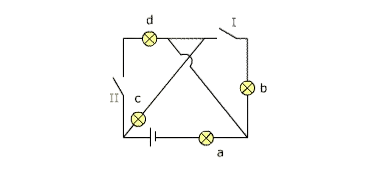
A. One
B. Two
C. Three
D. Four
E. None
Answer: the correct answer is C.
If you close switch I and leave switch II open (see the red line in the drawing), you can see that bulbs c, b, and a are still sitting on a closed circuit containing the battery.
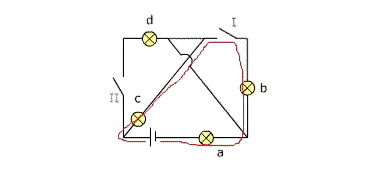
The branch containing bulb d is disconnected from the circuit, causing zero current to flow through it, and thus this bulb does not light up. Without it, only three bulbs would light up.
The correct answer is C
WorkKeys Applied Technology (Fluids) Test – Level 4 Question
The diagram below shows two tank and pump systems. In which system, will container V begin to fill up first?
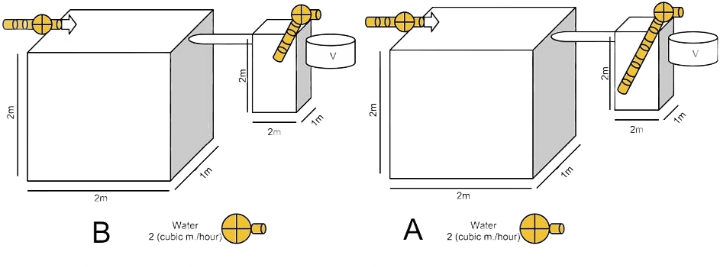
A. System A
B. The time will be identical
C. System B
D. Can't tell
E. Depends on the volume
Answer: the correct answer is A.
You can see that the two systems are virtually identical, except for the position of the pump in the smaller tank.
In the first system, the pump suctions from the bottom of the tank, whereas in the second system, the pump suctions from the middle of the tank; In practical terms, in the first system (A), the pump will start suctioning right away whilst in the second system (B), the smaller tank will have to be at least half full for the pump to start suctioning.
Therefore, container V will begin to fill in System A before it does in System B.
The correct answer is A
Mechanical Basics – The questions in Applied Technology, like the other questions in the ACT WorkKeys, are increasingly difficult. However, while the first three sections require arithmetic and reasoning skills, which are common and can be practiced instantly – Applied Technology questions require basic mechanical knowledge, both in concepts of mechanics and practice. It is recommended to review the basics again, to start your practice when you understand the questions and explanation provided.
To review basic mechanical, electrical and more questions with valuable tips, go to our Mechanical Aptitude Free Test.
WorkKeys Applied Technology (Electricity) Test – Level 5 Question
Q19: Before you are two globes filled with conducting material. You know that both contain a positive electrical charge of 2q. Another globe of material is then placed near the first two. The new globe has a positive charge of q. You measure one of the original globes and find that it now carries a negative charge of -q. What charge will the other globe have now?
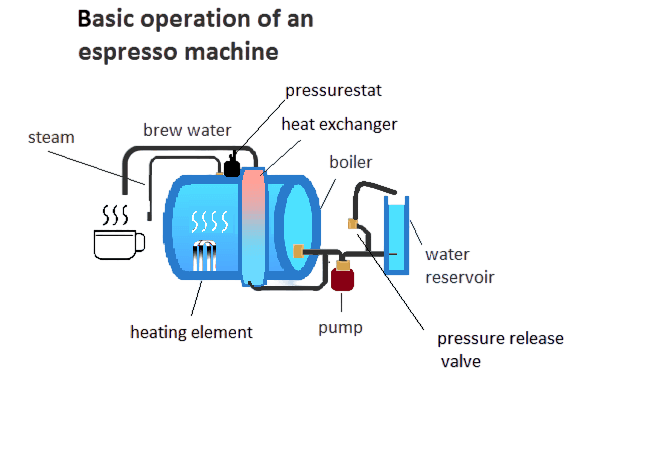
A. The globe will have a charge of -q
B. The globe will have a charge of 2q
C. The globe will have a charge of 3q
D. The globe will have a charge of q
E. The globe will have a charge of -2q
Answer: the correct answer is A.
You can see that the two systems are virtually identical, except for the position of the pump in the smaller tank.
In the first system, the pump suctions from the bottom of the tank, whereas in the second system, the pump suctions from the middle of the tank; In practical terms, in the first system (A), the pump will start suctioning right away whilst in the second system (B), the smaller tank will have to be at least half full for the pump to start suctioning.
Therefore, container V will begin to fill in System A before it does in System B.
The correct answer is A
WorkKeys Applied Technology (Mechanics) Test – Level 6 Question
Q19: Below are the schematics of your home coffee machine:

As you make your coffee, you notice the steamer giving out a stronger-than-usual steam jet. In addition, the coffee is very hot and almost boiling, and the coffee has a bitter, burnt taste.
You have checked the water tank to see that it is full, and there seems to be no other external problem (electricity, water blockage, etc.).
Where should you look for the problem?
A. The Heating Element
B. The heat exchanger
C. The pump
D. The pressurestat
E. The Brew waterpipe
Answer: the correct answer is D.
The pressurestat is the only element that can explain all the problems you have experienced. If the pressurestat was damaged, the heating would not stop upon reaching a certain pressure, thus causing a higher pressure (strength) steam jet. In addition, the high pressure/temperature of the water/steam resulting from a malfunctioning pressurestat could, in turn, "burn" the coffee.
Answer (A) is incorrect because there would be no hot water or steam if the heating element were damaged.
Answer (B) is incorrect because if the heat exchanger were damaged, the coffee would either be cold or too hot, but it would not affect the steam.
Answer (C) is incorrect because there would be no steam or water if the pump were damaged.
Answer (E) is wrong because it is just a pipe. It has no effect on the steam or temperature of the water.
The correct answer is D
Applied Technology questions vary in their content, and the assessment may include a mixture of topics (like those presented here) either equal or not, or a stand-alone topic. Practicing ahead to the test is crucial and will allow you to comprehend and answer questions quickly and efficiently. Check out our Applied Technology practice test.
You can also find guides and basic questions in different mechanical fields on our Mechanical Reasoning PrepPacks page.
How to best handle Applied Technology questions?
WorkKeys Practice Exam — Business Writing Sample Question
The WorkKeys Business Writing section has five difficulty levels, ranging from 1 to 5.
You will have one prompt to write in 30 minutes.
Q20. You are an employee at ABC Corp. and have noticed that many employees are often late to team meetings. This delays the start of the meeting and makes it difficult to cover all the agenda items within the scheduled time. Your manager has asked you to write an email to the team addressing this issue.
Write a formal email to your team outlining the importance of punctuality for meetings, the impact of tardiness on team productivity, and a request for everyone to make a conscious effort to be on time.
Subject: Importance of Punctuality in Team Meetings
Dear Team,
I hope this message finds you well. I'd like to address a concern that has been affecting our team's productivity—specifically, the punctuality of our team members at meetings.
The Importance of Timeliness
Being on time for meetings is not just a matter of protocol; it's a demonstration of respect towards your teammates and their time. Meetings are essential for collaboration, and punctuality ensures that we can start on time and cover all agenda items as planned.
Impact on Team Productivity
When we start late, we often must rush through agenda items or even postpone important discussions. This affects our ability to make timely decisions and can ultimately delay project timelines. Furthermore, it disrupts team members' schedules with other commitments and responsibilities.
Request for Timely Attendance
Given the impact of tardiness, I kindly request that everyone make a conscious effort to be on time for all team meetings. If you anticipate being late, please inform the meeting organizer in advance so appropriate adjustments can be made.
Thank you for your attention to this matter. Your punctuality benefits you and contributes to the entire team's success and productivity.
Best regards,
[Your Name]
When approaching a Business Writing question, start by writing the main points you will emphasize, imagine the text's overall structure, and divide between paragraphs. Here are three valuable key points to consider:
- Audience Understanding and Tone: Always keep your audience in mind. In this case, you're writing to your team, so you should maintain a professional and collegial tone. Be respectful and considerate, acknowledging the problem without assigning blame.
- Clarity and Structure: Organize your thoughts. Start with an introduction that outlines the issue, followed by the body of the text that goes into details, and conclude with a summary or call to action. Use headings, bullet points, or numbered lists to break up the text if appropriate.
- Grammar and Language: Ensure that your writing is grammatically correct and free of spelling errors. Use clear, straightforward language and avoid jargon unless it's industry-specific and you're certain the audience will understand.
Why is practicing grammar important for Business Writing?
The next section of our WorkKeys Practice Test is the Workplace Observation, which assesses your attention to details, ability to follow instructions or procedures, and capacity for critical evaluation and comparison.
WorkKeys Practice Exam — Workplace Observation Sample Question
The WorkKeys Workplace Observation section has five difficulty levels, ranging from 1 to 5.
You will have 55 minutes to write in 35 questions.
💡 Note that the scenarios will be presented in a short video on the actual test.
Q21.
Hey Team,
I hope you're all doing well. As you know, safety and efficiency are two of our top priorities here, so I wanted to review the proper procedure for operating our specialized machinery.
First and foremost, always ensure the machine is turned off before you even think about starting any operation. This is crucial for your safety and the safety of others.
Please wear all required safety gear once you've verified that the machine is off. That means gloves and goggles at a minimum. There are no shortcuts here; we want everyone to go home individually.
Now, let's talk about the control panel. There are four buttons you'll need to know:
- Red Button: This one stops the machine dead in its tracks. Use it in emergencies.
- Green Button: This is your go-to for starting the machine. But remember, only press this after you've set up your raw materials correctly.
- Yellow Button: Encountered an error? Don't panic. Just press the yellow button, and it will reset the machine and clear any issues.
- Blue Button: This puts the machine in maintenance mode. Use it only when you're performing scheduled maintenance tasks.
After you've set up your raw materials and are ready to go, hit that green button to get the machine running. If something doesn't seem right and an error pop up, just hit the yellow button to reset and clear the issue.
I hope this clears up any questions you might have had about operating the machine. Let's keep safety and efficiency at the forefront of everything we do.
Thanks for your attention, and please reach out if you have any questions.
Best, Sarah
What should be done according to Sarah's demonstration if the machine encounters an error during operation?
A. Turn off the machine and restart it.
B. Remove the safety gear and inspect the machine.
C. Press the Red button.
D. Press the Blue button.
E. Press the Yellow button.
Answer: the correct answer is E.
Sarah explicitly mentions that pressing the yellow button will clear any errors during the operation of the machine. According to the procedures she outlined, this is the correct action to take.
Answer (A): Sarah did not recommend turning the machine off and restarting to clear an error.
Answer (B): Removing safety gear is against the safety protocol and was not recommended by Sarah.
Answer (C): The Red button is for stopping the machine, but it was not specified for use when encountering an error.
Answer (D): The Blue button is for maintenance and was not recommended for clearing errors.
By paying close attention to the video demonstration, you could correctly answer that pressing the yellow button is the action Sarah recommended for clearing errors during operation.
The correct answer is E
The Workplace Observation test measures your skills in observing, following, understanding, and evaluating processes, demonstrations, and other forms of workplace instruction. You will be shown a video or demonstration containing certain details, procedures, or sequences. Afterward, questions are asked to gauge how well you've observed and understood what was presented.
Let's review the final sections of the WorkKeys Assessment Practice Test – the Personality Assessments. They aim to measure soft skills that are crucial for success in the workplace. We'll start with the Fit Assessment, which is tailored more toward determining if you will thrive within an organization's specific culture and work environment.
WorkKeys Practice Exam — Fit Sample Questions
The WorkKeys Fit section comprises two parts – the ACT Interest Inventory and the Work Values Inventory.
You will have 102 items to address in approximately 20 minutes.
WorkKeys Fit Assessment – ACT Interest Inventory Question
Q21. Rate the following activities:
Planning a workflow
Dislike
Indifferent
Like
Researching information
Dislike
Indifferent
Like
Pitching ideas
Dislike
Indifferent
Like
Since this test is an interest inventory, you should answer according to your beliefs and preferred position. However – notice that all three activities are positive concerning different positions – the first concerns the Business Operations scale, the second Science and Technology scale, and the third Administration and Sales scale.
WorkKeys Fit Assessment – Work Values Inventory Question
Q22. Rate the following activities:
Respecting Authority
Not important at all
Slightly Important
Important
Very important
Extremely important
Helping People
Not important at all
Slightly Important
Important
Very important
Extremely important
Public Contact
Not important at all
Slightly Important
Important
Very important
Extremely important
Once again, the responses are according to the desired position.
- High Authority is positive towards leadership positions.
- High Helping People is positive toward teaching and mentoring positions.
- High Public Contact is positive towards sales and public positions.
The last part of the WorkKeys Practice Test is the Talent section, which focuses on your personal characteristics and behavioral tendencies related to job performance.
WorkKeys Practice Exam — Talent Sample Questions
In the WorkKeys Talent section, you will have 165 items to address in approximately 35 minutes.
Q23. Rate the following activities:
I seldom rethink my choices
Strongly Disagree
Moderately Disagree
Slightly Disagree
Slightly Agree
Moderately Agree
Strongly Agree
People who take too long to take action irritate me
Strongly Disagree
Moderately Disagree
Slightly Disagree
Slightly Agree
Moderately Agree
Strongly Agree
Proven truths, not possibilities, support my judgments
Strongly Disagree
Moderately Disagree
Slightly Disagree
Slightly Agree
Moderately Agree
Strongly Agree
The answers in this test will be demonstrated by creating a profile, which demonstrates different indices and traits. Let’s review to which one each statement refers to:
- The first statement refers to Discipline, as it shows how much you reflect on your decisions and can be reliable.
- The second statement refers to Goodwill, as it refers to your perception of others and their actions.
- The third statement refers to Carefulness, as it demonstrates the extent to which you consider the consequences of your potential actions.
Prepare with JobTestPrep's ACT WorkKeys practice test and gain the tools necessary to excel and earn your National Career Readiness Certificate:
- Master the Applied Math, Graphic Literacy, Workplace Documents, Applied Technology, and Business Writing sections of the test with our realistic simulations.
- Experience consistent improvement with our detailed step-by-step explanations.
- Track your progress with comprehensive scoring reports for every practice test you complete.
- Elevate your writing skills with our Study Guide & Grammar Practice.
WorkKeys Assessment Practice Test FAQ
The key to succeeding in the WorkKey is solving questions methodically, using formulas and a calculator for the Applied Mathematics Section, and practicing the different types of questions before the test so you are familiar with the test's content. Keep these in mind, and you are all set.
You can take the test again after 30 days, but you will have to register for it again.
You can redo the test as many times as you wish. Just make sure to practice your weak spots before.




